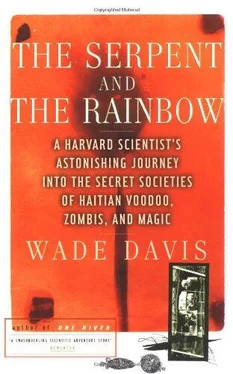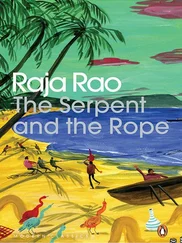Wade Davis - The Serpent and the Rainbow
Здесь есть возможность читать онлайн «Wade Davis - The Serpent and the Rainbow» весь текст электронной книги совершенно бесплатно (целиком полную версию без сокращений). В некоторых случаях можно слушать аудио, скачать через торрент в формате fb2 и присутствует краткое содержание. Год выпуска: 1985, Издательство: Simon & Schuster, Жанр: Старинная литература, на английском языке. Описание произведения, (предисловие) а так же отзывы посетителей доступны на портале библиотеки ЛибКат.
- Название:The Serpent and the Rainbow
- Автор:
- Издательство:Simon & Schuster
- Жанр:
- Год:1985
- ISBN:нет данных
- Рейтинг книги:5 / 5. Голосов: 1
-
Избранное:Добавить в избранное
- Отзывы:
-
Ваша оценка:
- 100
- 1
- 2
- 3
- 4
- 5
The Serpent and the Rainbow: краткое содержание, описание и аннотация
Предлагаем к чтению аннотацию, описание, краткое содержание или предисловие (зависит от того, что написал сам автор книги «The Serpent and the Rainbow»). Если вы не нашли необходимую информацию о книге — напишите в комментариях, мы постараемся отыскать её.
The Serpent and the Rainbow — читать онлайн бесплатно полную книгу (весь текст) целиком
Ниже представлен текст книги, разбитый по страницам. Система сохранения места последней прочитанной страницы, позволяет с удобством читать онлайн бесплатно книгу «The Serpent and the Rainbow», без необходимости каждый раз заново искать на чём Вы остановились. Поставьте закладку, и сможете в любой момент перейти на страницу, на которой закончили чтение.
Интервал:
Закладка:
There was another possibility. If your spiritual force was strong, Marcel Pierre had told us, you could resist a spell, but the powder promised to get you anyway. Mme. Jacques mentioned powders that were rubbed into the skin or placed in wounds; she had talked of glass ground in the mortar, of the skin ripped by a thorn. These had to be the pharmacologically active powders that allowed the zombi to rise. It was what Narcisse had said. On the Sunday before his death, they took him before the basin and pricked his skin, and the water turned to blood! Herard was right. If you wanted a zombi of the flesh to rise, a little powder sprinkled on the ground would never do!
My third question was interrupted by the arrival of the president of the local secret society. At that point the army commander, who had returned while I had been questioning Herard, was reduced to serving us rum and food. Herard discussed the possibility of obtaining a zombi cadavre for medical study. It was not until the middle of the night that we finally agreed on a price. Herard arranged to meet again with the president and his people the next afternoon. As we drove out of town, I attempted to arrange a time to meet the following day.
“No. No,” Herard laughed, “we don’t return tomorrow. I just wanted to measure their force.”
“But how will they bear the insult?” I asked, recalling the somewhat ominous warning of LaBonté at Petite Rivière de Nippes. “Are not the societies everywhere?”
“Yes, they are powerful,” he agreed. “That’s why you had to come here with someone who is stronger. I, too, represent a secret society. Mine is a society of one!”
Then, as if to emphasize that there were limits to even his own authority, he warned me that around Petite Rivière de l’Artibonite anything could happen. The road forked and he pointed to the shadows.
“Be especially careful at the crossroads. Never leave your car after dark. They move by night.”
As we approached Gonaives, I felt compelled to ask a final question, the one that I myself would be asked so often. Why was he giving me all this information? He laughed, but did not respond until we reached his house. Then, just as he left the jeep, he looked back at me.
“Mon petit malfacteur, you are not a fool, but you still do not understand. You may gather your powders; in fact, I will give you all the powders you want. You will meet zombis, you may see zombis come from the earth, you will even think that you understand zombis. But you will never make a zombi, nor will you leave here with the magic.
“Someday when you stop asking all these questions, you will begin to see. Only then will you begin to know vodoun, and only then will you step into the path of the loa.”
For all his gruff manner, Herard had provided more information concerning the poison than anyone else; yet of all my contacts in Haiti, he had, expressed the most disdain for such powders, and the least interest in zombis. He was a deeply religious man, a theologian really. Sometimes when Herard said things I had no idea what he meant; at other moments his words seemed like a beacon. It was time I tried to understand the spirit world of his people.
10
The Serpent and the Rainbow
ON JULY 16, 1843, and then again on the same day in 1881, the Virgin Mary appeared on the top of a palm tree near the village of Ville Bonheur in the rugged mountains of central Haiti. She said the world was going to end. This was most convenient for the Roman Catholic church, for the palm tree grew not far from the base of a cliff where the La Tombe River dissolves into mist, a waterfall named Saut d’Eau that had been a sacred vodoun pilgrimage site for a good many years. The Catholic priests, then as always anxious to purge the nation of what they considered a pagan cult, took immediate advantage of their good fortune. A chapel and shrine were erected, the legitimacy of the apparition was verified by church authorities, and thenceforth the miraculous event was commemorated annually with a full day of religious celebrations. But a strange twist was soon added to the saga. With increasing frequency, the officiating priests found small plates of food placed alongside the votive candles at the Virgin’s shrine. Once they realized what was going on, their initial enthusiasm faded rapidly. Rather than their co-opting a traditional vodoun pilgrimage, quite the opposite had taken place. For the peasants, the apparition of the Virgin Mary was none other than Erzulie Freda, the goddess of love, and her presence was less a miracle than an expected blessing that only added to the reputation of the sacred waterfall.
The Virgin next appeared during the American occupation, and by then the clergy was prepared. A local priest dismissed the apparition as idle superstition and called upon a Marine captain stationed in the region to help suppress the worship. The Marine complied, ordering a Haitian sergeant to shoot into the blinding light. As he did so, the vision moved to another palm, and then another, until the exasperated priest ordered the trees cut down. The vision rose above the canopy, and as the last of the palms fell, it changed into a pigeon. For a moment the priest was satisfied, but just as he turned to leave word came that his house had burned down, destroying all his possessions. This calamity was only the beginning for him; within a week the priest lay dead, the victim of a paralytic stroke. The American was similarly punished, and the Haitian sergeant went insane and was found sometime later wandering alone in a forest near the village. From what the townspeople say the pigeon remained close to Ville Bonheur for several days and then flew to Saut d’Eau, where it disappeared into the iridescent mist.
The waterfall at Saut d’Eau carves a deep hidden basin from a limestone escarpment, and by the time I arrived shortly after midnight the entire vault was bathed in the soft glow of a thousand candles. Already in the depths where no moonlight could fall, huddled together, or darting in and out of the water, singing the vodoun songs or serving the many altars, were dozens and dozens of pilgrims. On all sides, people saturated with a lifetime of heat shivered and trembled, drawing in their hands against their naked skin. High above on the trail along which I had passed, other seekers had abandoned themselves to their goal and drifted along the horizon with the motion of night clouds. Overhead, beyond the crown of the towering mapou tree that hovered over the basin, the branches of heaven spread and the stars scattered as thick as blossoms in the northern spring.
Vodoun is not an animistic religion, Max Beauvoir had told me. The believer does not endow natural objects with souls; they serve the loa, which by definition are the multiple expressions of God. There is Agwe, the spiritual sovereign of the sea, and there is Ogoun, the spirit of fire and the metallurgical elements. But there is also Erzulie, the goddess of love; Guede, the spirit of the dead; Legba, the spirit of communication between all spheres. The vodounist, in fact, honors hundreds of loa because he so sincerely recognizes all life, all material objects, and even abstract processes as the sacred expressions of God. Though God is the supreme force at the apex of the pantheon, he is distant, and it is with the loa that the Haitian interacts on a daily basis.
The spirits live beneath the great water sharing their time between Haiti and the mythic homeland of Guinée. But they often choose to reside in places of great natural beauty. They rise from the bottom of the sea, inhabit the rich plains, and clamber down the rocky trails from the summits of the mountains. They dwell in the center of stones, the dampness of caves, the depth of sunken wells. The believer is drawn to these places as we are drawn to cathedrals. We do not worship the buildings; we go there to be in the presence of God. That is the spirit of the pilgrimage.
Читать дальшеИнтервал:
Закладка:
Похожие книги на «The Serpent and the Rainbow»
Представляем Вашему вниманию похожие книги на «The Serpent and the Rainbow» списком для выбора. Мы отобрали схожую по названию и смыслу литературу в надежде предоставить читателям больше вариантов отыскать новые, интересные, ещё непрочитанные произведения.
Обсуждение, отзывы о книге «The Serpent and the Rainbow» и просто собственные мнения читателей. Оставьте ваши комментарии, напишите, что Вы думаете о произведении, его смысле или главных героях. Укажите что конкретно понравилось, а что нет, и почему Вы так считаете.












